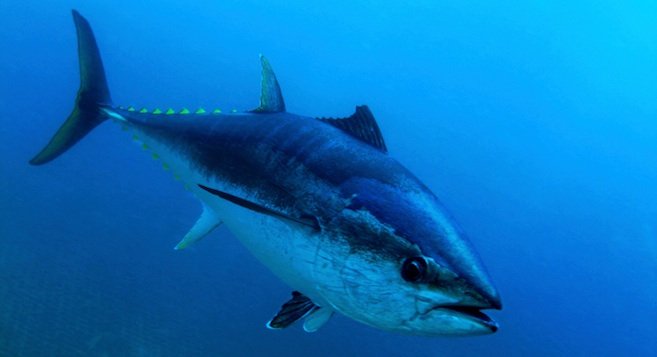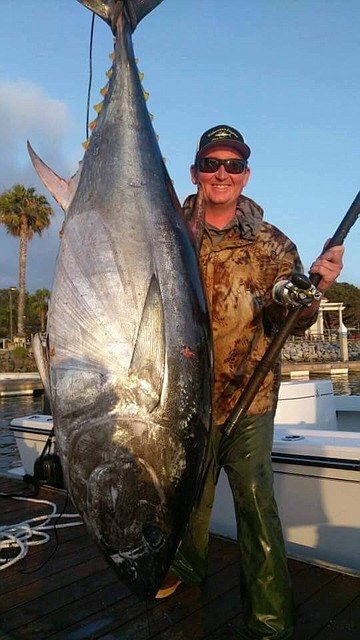 Facebook
Facebook
 X
X
 Instagram
Instagram
 TikTok
TikTok
 Youtube
Youtube

Bluefin should become an endangered species, thus banning all fishing of the large tuna on the West Coast, says the Center for Biological Diversity.
Wayne Kokow of Rancho Peñasquitos is the executive director of the California chapter of the Coastal Conservation Association. He says the center is completely incorrect. “The spawning grounds for the bluefin is in Japan,” he said.
According to a chart recently published in the L.A. Times, Japan’s fleet is the largest taker of bluefin. The bluefins migrate back and forth across the ocean from Asia’s East Coast to our West Coast. A full adult reproductive bluefin should weigh at least 130 pounds. Local anglers are only catching the 30- to 70-pounders. It’s the unregulated Asian take that is hurting the species, say sportsmen.
In 2015, new regulations limited the bluefin take from ten to two fish in local waters. “When the fish disappear, regulators assume we’ve over-fished the resource,” said Kokow. “In actuality, they’ve just moved somewhere else, like Mexico.”

Kokow pointed out if the bluefin catch on the West Coast is completely banned, it still doesn’t reduce the demand. “Because of current regulations, we don’t land and process bluefin anymore,” said Kokow. Most of the U.S. fleet is now flagged as ships from other countries, docking in China, Japan, Philippines, or Vietnam, for processing and canning. “So, we catch and export our A+ product and we get back [in the American marketplace] D+ quality.”
The National Marine Fisheries Service, a regulatory agency under NOAA, is entrusted with declaring fish species as endangered. The body had 90 days to determine if the biodiversity center’s recent filing is valid and thus if bluefin will be listed as endangered.
Kokow says the coastal conservation’s national organization has full-time lobbyists working in Washington DC to stop the complete ban on catching bluefin.
Founded in 1998, the Tucson, Arizona–based Center for Biological Diversity is a well-funded group of environmental activists claiming a membership of 625,000 people.


Bluefin should become an endangered species, thus banning all fishing of the large tuna on the West Coast, says the Center for Biological Diversity.
Wayne Kokow of Rancho Peñasquitos is the executive director of the California chapter of the Coastal Conservation Association. He says the center is completely incorrect. “The spawning grounds for the bluefin is in Japan,” he said.
According to a chart recently published in the L.A. Times, Japan’s fleet is the largest taker of bluefin. The bluefins migrate back and forth across the ocean from Asia’s East Coast to our West Coast. A full adult reproductive bluefin should weigh at least 130 pounds. Local anglers are only catching the 30- to 70-pounders. It’s the unregulated Asian take that is hurting the species, say sportsmen.
In 2015, new regulations limited the bluefin take from ten to two fish in local waters. “When the fish disappear, regulators assume we’ve over-fished the resource,” said Kokow. “In actuality, they’ve just moved somewhere else, like Mexico.”

Kokow pointed out if the bluefin catch on the West Coast is completely banned, it still doesn’t reduce the demand. “Because of current regulations, we don’t land and process bluefin anymore,” said Kokow. Most of the U.S. fleet is now flagged as ships from other countries, docking in China, Japan, Philippines, or Vietnam, for processing and canning. “So, we catch and export our A+ product and we get back [in the American marketplace] D+ quality.”
The National Marine Fisheries Service, a regulatory agency under NOAA, is entrusted with declaring fish species as endangered. The body had 90 days to determine if the biodiversity center’s recent filing is valid and thus if bluefin will be listed as endangered.
Kokow says the coastal conservation’s national organization has full-time lobbyists working in Washington DC to stop the complete ban on catching bluefin.
Founded in 1998, the Tucson, Arizona–based Center for Biological Diversity is a well-funded group of environmental activists claiming a membership of 625,000 people.
Comments